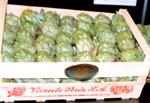| Fruits |
Vegetables
|
Artichoke, Cynara scolymus / Compositae (Asteraceae)
Postharvest Atmosphere Management

Artichokes are not usually subject to pre-cooling, although this product benefits from a fast decrease of the temperature down to 0-4ºC. Among the processes they can be put under, the use of frozen water is the best one. Vacuum cooling is also appropriate. Other less used methods are humid forced air and pre-cooling in cold storage rooms.
The artichoke is not usually stored because it looses quality and for economic reasons. Besides, it is highly perishable, and therefore its storage is quite problematic. At temperatures between 0 and 1ºC and with 95% of moisture levels, the period of conservation is only of 15 to 30 days. If they are subject to pre-cooling and plastics are used, then this period may be of 45 days.
Many authors have carried out research on the use of modified atmosphere and the results obtained are positive. Under conditions of 1ºC, 85-95% of moisture, levels of oxygen of 2% and carbon dioxide levels of 3-4%, the artichokes of the variety "Blanca de Tudela’ have been kept for 4 weeks. This technique helps to reduce blight problems, loss of weight, chilling sensitivity and alterations in the leaves that protect the capitulum.
The artichoke is not usually stored because it looses quality and for economic reasons. Besides, it is highly perishable, and therefore its storage is quite problematic. At temperatures between 0 and 1ºC and with 95% of moisture levels, the period of conservation is only of 15 to 30 days. If they are subject to pre-cooling and plastics are used, then this period may be of 45 days.
Many authors have carried out research on the use of modified atmosphere and the results obtained are positive. Under conditions of 1ºC, 85-95% of moisture, levels of oxygen of 2% and carbon dioxide levels of 3-4%, the artichokes of the variety "Blanca de Tudela’ have been kept for 4 weeks. This technique helps to reduce blight problems, loss of weight, chilling sensitivity and alterations in the leaves that protect the capitulum.
Distribution
The artichokes transport must be carried out at low temperatures, preferably at 0ºC and 95% of moisture. However, temperatures of 10ºC are allowed if the journey lasts between 2 and 3 days.
The distribution must be carried out at temperatures below 20ºC, with average humidity and weak ventilation.
The distribution must be carried out at temperatures below 20ºC, with average humidity and weak ventilation.
Postharvest Problems
Among the most frequent problems during the storage of the artichoke there are certain alterations such as the loss of weight, blight or the appearance of strange colours. Among the diseases, the most important it is the fungus Botrytis cinerea.
The artichokes are very perishable products that may undergo several problems during their storage, such as physiological alterations and diseases. Among the alterations there are:
Blights caused by water loss; this can be avoided or reduced by maintaining appropriate levels of moisture and closed packages.
Loss of weight: it is basically caused by the loss of water. In approximately 7 days there may occur a loss of 4% of weight.
Colour alterations: violet shades and inner browning may appear in the leaves that protect the inflorescence.
Among the diseases we mention the following:
Botrytis cinerea: this fungus is the most important in the postharvesting of artichokes, giving birth to gray rot. It occurs in the external leaves and peduncle. In damp conditions there appear areas of reddish brown or brown colour, wet and odourless. In dry conditions the injuries show a dark brown colour. Finally, these areas develop a gray down. Low temperatures help to reduce this problem.
The artichokes are very perishable products that may undergo several problems during their storage, such as physiological alterations and diseases. Among the alterations there are:
Blights caused by water loss; this can be avoided or reduced by maintaining appropriate levels of moisture and closed packages.
Loss of weight: it is basically caused by the loss of water. In approximately 7 days there may occur a loss of 4% of weight.
Colour alterations: violet shades and inner browning may appear in the leaves that protect the inflorescence.
Among the diseases we mention the following:
Botrytis cinerea: this fungus is the most important in the postharvesting of artichokes, giving birth to gray rot. It occurs in the external leaves and peduncle. In damp conditions there appear areas of reddish brown or brown colour, wet and odourless. In dry conditions the injuries show a dark brown colour. Finally, these areas develop a gray down. Low temperatures help to reduce this problem.
| Interempresas Media, S.L. / 2026 | [ Legal notice | Política de Protección de Datos | Política de cookies | Publicidad] |
